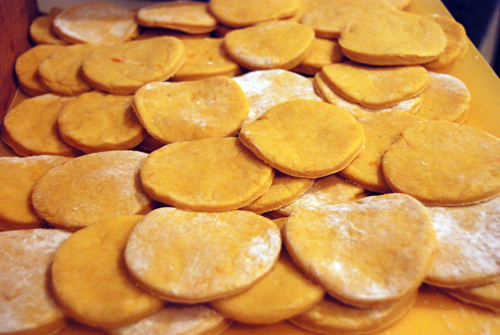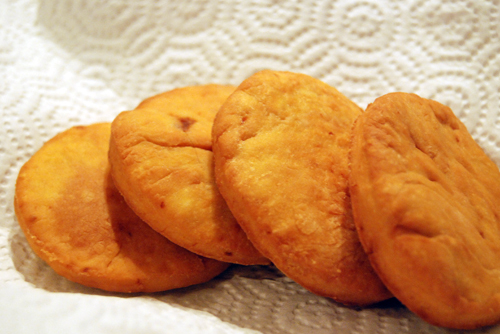
This morning I awoke to cold, gray skies that seem to thicken by the minute with moisture. The weekend forecast? Rain. Brrr. In these chilly days of winter, my former American self would normally pine for matzah ball soup, chicken pot pie, and hot chocolate to take the edge off the cold (and lack of central heating). Now, when rain is inevitable, my culinary radar immediately hones in on visions of sopaipillas, pillowy pumpkin bread.
Sopaipillas are deeply rooted in the collective gastronomic nostalgia of Chileans. Particularly on rainy days, Chileans dream of coming home to a warm kitchen filled with the sweet smell of these fried breads. Biting into these hot stacks at onces with a steaming cup of tea instantly raises your body and transports most people to memories of their childhood. A comfort food at heart, sopaipillas are also dunked briefly in thick molasses-like syrup, chancaca, aromatized with orange peel and cinnamon. They are lovingly called sopaipillas pasadas, “soggy sopailpillas”, as they sop up all the sweet nectar.
Sopaipillas prevalence is surely due to the abundance of pumpkin grown year-round in Chile. Ranging in maturity from light yellow in the summer to a deep orange in the winter as the gourds mature, the flesh is boiled or roasted and kneaded into the dough. In the south on the island of Chiloé, potatoes (sweet or plain) replace the pumpkin and sopaipillas are many times the daily bread on tables at breakfast and tea time.

Sopaipillas are also sold throughout the country as street food from carts where they are eaten usually for breakfast, piping hot with boiling cups of nescafé on cold winter mornings. Although delicious plain, the brave-hearted tingle their palates by adding a dollop of spicy chili sauce on top.
Typically sopaipillas measure 4-inches wide, although many restaurants now serve smaller 2-inch versions. Perfect for light snacks before dinner with the classic fresh tomato-cilantro pebre, or with onces on a cold, rainy day, leftovers also are fantastic toasted for breakfast or grilled with Chile’s addictive, mild queso fresco, similar to the Mexican cheese now found in most US supermarkets.
Yield: 5 dozen
3 1/2 cups (about 2 ½ pounds or 1 kilogram) cooked mature pumpkin (Substitute: butternut squash)
1/4 pound (125 grams) vegetable shortening, softened
2 teaspoons sea salt
8 cups (roughly 1 kilogram) plain (all-purpose) flour
2 teaspoons baking powder
½ cup water, lukewarm
1 quart (1 liter) vegetable oil for frying
Preheat the oven to 200ºC/400ºF.
Cut the pumpkin in medium-sized cubes and place on a greased oven tray. Massage with a few drops of olive oil and cook until tender, about 20 minutes. Remove and let cool slightly.
Mash the pumpkin while warm, using a ricer. Alternately, use a food processor, pulsing to purée thoroughly. Add the softened shortening and salt to the pumpkin. Sift the flour and baking powder together and add in batches to the dough until it is no longer wet and does not stick to your hands. Dust your hands with flour as necessary throughout the kneading process. If the dough is on the dry side, add the water little by little, kneading to incorporate. The dough should be soft but not elastic or rubbery.
Tear off walnut-sized balls and roll out to 1/4-inch (5 millimeters) thickness. Using a circular biscuit cutter with a 2 ¼-inch (6 centimeter) diameter cut into rounds. In a pinch, a clean tin works brilliantly. Collect the scraps and knead back into a ball until all dough has been used. If you do not wish to immediately prepare all the sopaipillas, you can wrap them in wax paper to freeze for up to 3 months.
Fill a deep pan or wok with several inches of clean vegetable oil. Heat over high heat for 10 minutes. Test a small piece of dough for temperature. The dough should turn golden brown. Add each sopaipilla to the hot oil and fry for 1-2 minutes on each side until golden brown. The sopaipillas will puff up slightly as they cook. Drain on paper towels. Serve hot with chili sauce or tomato pebre. If you wish to eat them sweet, drizzle them with honey, maple syrup, or the molasses recipe below.

Molasses Syrup for Sopaipillas Pasadas
2 cups molasses (substitute: Demerara sugar)
2 cups water
Whole cinnamon stick
Orange peel slices from one orange
In a large pot that will hold the sopaipillas, bring the water to a simmer. Add the molasses, cinnamon, and orange and fully dissolve molasses. Lower heat and let simmer for 5-10 until the syrup thickens slightly. Add the sopaipillas and submerge them in the syrup for about a minute. Serve immediately on a plate to catch the sweet, sticky sauce.












